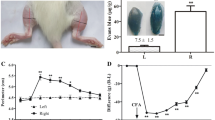Abstract
Peptides released from sensory nerves during an axon reflex are thought to cause mast cell degranulation, histamine (Hi) release and Hi-induced vasodilatation leading to the flare of the triple response. Capsaicin stimulates peptide release from sensory neurones and causes flarein vivo but does not cause Hi release from mast cellsin vitro. The effects of capsaicin on mast cell degranulation in human skinin vivo has been studied by histological examination of skin biopsies after topical capsaicin (1%) treatment of stratum corneum-denuded forearm in four volunteers. The results show a significant reduction in the visible numbers of mast cells and the appearance of degranulated mast cell ghosts in the skin six hours after capsaicin application. Since capsaicin itself does not release Hi from mast cells, these data suggest that capsaicin-induced release of peptides from neurones could cause mast cell degranulation.
Similar content being viewed by others
References
J. C. Foreman, C. C. Jordan, P. Oehme and H. Renner,Structure-activity relationships for some substance P-related peptides that cause weal and flare reaction in human skin. J. Physiol.335, 449–465 (1983).
J. C. Foreman and C. C. Jordan,Neurogenic inflammation Trends in Pharmacol. Sci.5, 116–119 (1984).
J. C. Foreman,Neuropeptides and the pathogenesis of allergy Allergy42, 1–11 (1987).
P. J. Barnes, M. Brown, C. Dollery, R. W. Fuller, D. J. Heavey and P. W. Ind,Histamine is released from skin by substance P but does not act as the final vasodilator in the axon reflex. Br. J. Pharmacol.88, 741–745 (1986).
J. C. Foreman,Interaction between neuropeptides and classical mediators of allergy. InProgress in allergy and clinical immunology. pp. 82–85 (Eds. W. J. Pichler, B. M. Stadtler, C. A. Dahnden, A. R. Pécond, P. Frei, C. H. Schneider and A. L. de Weck). Hogrefe and Huber, Toronto 1989.
S. D. Brain, D. C. Crossman, T. L. Buckley and T. J. Williams,Endothelin-1: Demonstration of potent effects on the microcirculation of humans and other species. J. Cardiovasc. Res.13, (Suppl. 5), 5147–5149 (1989).
Author information
Authors and Affiliations
Rights and permissions
About this article
Cite this article
Bunker, C.B., Cerio, R., Bull, H.A. et al. The effect of capsaicin application on mast cells in normal human skin. Agents and Actions 33, 195–196 (1991). https://doi.org/10.1007/BF01993165
Issue Date:
DOI: https://doi.org/10.1007/BF01993165




